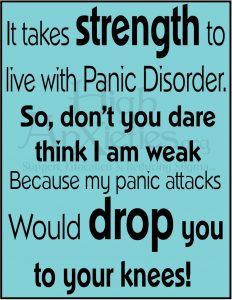URGENT CARE FOR PANIC
Panic attacks can be terrifying. Full-blown panic comes out of nowhere and attacks with a rapid-fire outbreak of major stress symptoms that create fear and anxiety. The essence of panic is an intense anxiety reaction coupled with a bout of bodily stress symptoms, largely unexpected, that occurs out of context – an activity, situation, or event – where there’s no immediate, mortal danger.
Panic is an intense emotional reaction to bodily symptoms. So “Urgent Care” for panic involves reducing the disturbing power of the disturbing physical and emotional feelings, becoming able to realize that you aren’t in jeopardy, and engaging specific skills for working with your mind to gain the upper hand over panic.
The Psychology of Panic
Vulnerability. Panic renders us very vulnerable – feeling physically shaken, veering between unhelpful behavioral impulses (like the urges to flee, freeze like a deer in the headlights, or blurt out unspeakable obscenities), our minds roiling with scary thoughts. We feel drained and fragile once it’s over, afraid that we’ve been damaged mentally, physically, or both.
The “Fear Factor”. I call “the pounding heart of panic” the Fear Factor. It grips us with wildly threatening, catastrophic fears and utter fantasy – such as the scary fantasy of unconsciously flooring your car’s accelerator when you want to apply the brakes, or the fear of being suctioned off the edge of the roof of a building by mysterious forces and hurtling to doom. Although very frightening, it poses no actual danger: Our thinking is simply chaotic – confused and disorderly, rampant with irrational impulses and frightening thoughts.
Recognition of the role played by the Fear Factor during attacks is a key first step in learning to overcome Panic Disorder. It’ isn’t that the world has become scarier; it’s just that you’ve become much more sensitive to the edgy aspects – more conscious and susceptible to anxiety and panic. These fears don’t have solid roots in concrete reality. They rise and then diminish. Strength can immerge out of our vulnerable state: Instead of responding as though “not knowing what to think” is a problem, we can learn what to think and do next and discover we feel stronger.
By getting your head around the Fear Factor, facing the reality of being anxious and panic, and trying to accept and ultimately tolerate it, you begin to get better.

Photo Credits: HighAnXieties.org
Panics are real and they’re psychological – entailing sensations, thoughts, emotional feelings, and behavioral impulses. We humans are “factory equipped” with the Fight-Flight-Freeze (“F3”) response, the automatic fear (anxiety or anger) response to immediate, mortal danger, acute threat, and emotional stress that’s hard-wired into our psyches. During panic attacks, we have an F3 response that’s a false alarm.
What stimulates panic? Panic is stimulated by a sense of stress, menace, or threat. The stimulus may be internal or external in origin, actual or imagined. A slender, long, dark object laying directly across a hiker’s path causes an automatic fear reaction because she imagines IT’S A SNAKE – though it’s a stick! An internal threat trigger could be a pounding heart induced by imbibing an energy drink or a double shot of espresso. An external trigger might be driving around a curve on a freeway, only to be confronted by a massive traffic deadlock, or turning a corner in your office and coming to face-to-face with your boss glaring at you, looking crazed.
Said the salami to the baloney, “The wurst is yet to come!”
Panic is the worst-case scenario. During panic, our thoughts automatically, irrationally get captivated by full catastrophe thinking. Our instinctive “flight or freeze” reactions are instantly mobilized, and we irrationally fear that major upheavals or personal disasters are in the works.
Knowledge is a very potent antidote to panic: By allowing ourselves to become intimately familiar with what’s really going on, we can take heart, get the upper hand, and outsmart panic.
Correcting Scary Misconceptions
- Panic does not cause tissue damage, any more than sneezing fits, which are physical, cause emotional disturbance.
- Panic doesn’t place in us in jeopardy. There’s no added risk of stroke or of heart attack. They’re not a gateway to becoming psychotic, nor do they eradicate your self-control. They’re just intense.
Emotional intensity doesn’t need to be feared.
Reducing the Power of Panic
I’ve developed a swift treatment for panic disorder which I utilize with my clients. I’ll share it with you now. It takes valor to face your fears, but this treatment can sometimes totally turn the tide for panic attack sufferers.
The purpose of this treatment is to help you become stronger, clearer, and steadier when you face anxiety and panic. It’s not intended to stifle or magically “switch off” panic. Trying to do that is actually bad for us. t’s an unhealthy response to disturbing feelings called “Emotional Avoidance” which aggravates our distress.
Swift Treatment of Panic
- Acknowledge disturbing body anxiety and feelings of panic as soon as they begin to occur.
- Pause: Press the “mental pause button”. For just a few moments, intentionally suspend your automatic, catastrophic thinking, the scary stories and chaotic, panicky thoughts.
- Abide: Practice abiding, a key process of learning to steady yourself, starting to clear your mind, and gathering strength. To do so, use the aids of mindful breathing and realistic self-talk (see below).
- Proceed in a valued direction: Spend a few moments moving forward toward something you care about while being genuinely kind to yourself.
- Acknowledge: The forerunner of panic is generally disturbing body anxiety or heightened bodily tension. Let yourself know when situations, issues, and activities “just feel wrong”, because of:
- An internal tensing up of clenching
- Trembling inside
- Sensations of an anxiety or panic attack coming on.
Then acknowledge it and deliberately label it. You don’t cause panic by labeling it, but acknowledging is a crucial first step toward relief. “Acknowledging” means “letting ourselves know”; and knowledge is a powerful antidote to fear. It is decentering – seeing your thoughts and feelings as temporary events that aren’t actually part of you and aren’t necessarily truly reflecting reality. So say to yourself, “I’m beginning to feel panicky”, “My anxiety’s kicking up”, or “I might have a panic attack.”
-

Photo Credits: “Audrey Hepburn in Charade, posted in Wikimedia.org/wikipedia/commons”Pause: Next, press the “mental pause button”: For a few moments, pause whatever anxiety-driven story or imagining has been going through your mind and suspend the catastrophic thinking or chaotic thoughts related to panic. A useful visual aid is to look at two fingers that you hold up vertically, parallel to each other – replicating the “Pause Button” symbol in your electronic devices.
This “therapeutic pause” or “noble pause” enables you to put the momentum of pressurized anxiety on hold. Stop in your tracks, explore your feelings. and allow the higher-functioning, executive portions of your brain to re-engage.
- Abide: Abiding is learning to steady yourself when you are anxious, to stay the course, to exert the strength to achieve enough clarity to start changing things for the better. To achieve this beneficial effect, start by attempting to abide with your anxiety for just a short while – between about half a minute and a few minutes.
To Abide Peacefully – Aids to Abiding
You probably should start by working with your breath (though you might find you prefer to begin by modifying your self-talk). During panic attacks, many of us automatically switch to “panic breathing” – rapid and shallow, with much larger in-breaths than out-breaths. This breathing style feels frantic and increases over-stimulation. So instead,
A. Try simply to slowwww your breaths somewhat and regulate the breathing – even it out. Extend the out-breaths so they’re closer in length and strength to the in-breaths. OR engage in
B. Brief, Mindful Breathing – Pay careful attention simply to whether you’re breathing in or breathing out at present. Say “in” in a quiet mental voice with each in-breath and “out” with each out-breath. Don’t judge the speed, depth, or evenness of your breathing; if your mind drifts, bring it back to the breath itself. Try to take three to five “aware, mindful” breaths. That’s it. The effort you make will be worthwhile. Don’t make it a big deal.
C. Self-talk – Bring to mind any pearls of wisdom for coping with anxiety that you’ve worked out or acquired. Examples might include, “I am not my anxiety.”; “This panic won’t last, panic can’t harm me, it’ll just be a few really crummy minutes.”; or “My worries and anxieties are irrational – they’re not about reality.”
Panic is not actually a catastrophe, just a mental event. Consider a reasonable alternate perspective.
- Proceed in a valued direction: Consider actions in accord with your values that you can take – actions that move you away from grip of chaotic feelings. Prepare a list of the areas of life that you currently consider meaningful, valuable, or important – those that you care about deeply or hold close to your heart. Remind yourself of the important, valued areas; and then decide what you’d care to do more of right now, or what would be best to do next. For instance: call a friend if it’s understanding or warmth you’d value right now; stretch or walk peacefully for a few moments if you’d like to feel more tuned in to your body; pray or engage in brief breathing meditation to feel more centered spiritually; or just listen to calming music or run cool water over your wrists to soothe yourself.
Utilize this 4-step technique whenever you feel panicky.
David Mellinger, MSW, LCSW, BCD, is in private psychotherapy practice in Agoura Hills.
For more information, or to make an appointment, please call 818-716-1695.
